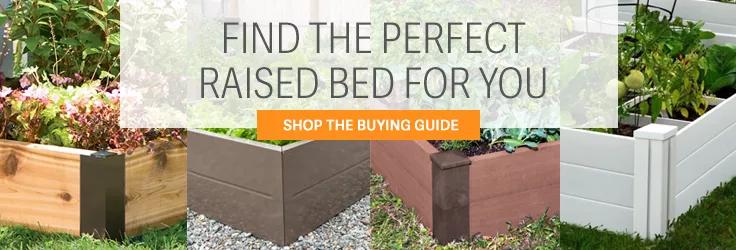Choosing a Raised Bed

About Raised Beds
Raised garden beds offer numerous benefits for both beginners and experienced gardeners. These elevated planting structures can be filled with high-quality, nutrient-rich soil for improved drainage, enhanced plant health, and reduced risk of compaction. By lifting beds above ground level, gardeners can also prevent weed growth, minimize pests, and extend the growing season, as the soil warms up faster in spring. Raised beds are also easier on the back and knees, as they reduce the need for bending over. Moreover, they provide better control over moisture levels, allowing for more efficient irrigation. With various material options including wood, stone, or metal, raised garden beds can be customized to fit any garden style or space, making them an ideal option for urban and small-space gardening. Enjoy:
- Improved Soil Drainage: Raised garden beds promote better drainage, preventing waterlogging and root rot that inhibit healthy plant growth. With well-drained soil, plants have optimal access to nutrients and oxygen, making raised beds ideal for growing a wide variety of crops.
- Reduced Weeds and Pests: Raised garden beds help minimize weed growth and provide easier control over pests. With fewer weeds to compete with your plants and a higher elevation to keep pests at bay, raised beds create a healthier, more manageable gardening environment.
- Enhanced Accessibility: Raised garden beds are easier on the back and knees, especially for those with limited mobility or those who experience joint pain. By elevating your planting space, these beds reduce the need for bending, making gardening more comfortable and accessible for all ages.
- Extended Growing Season: The elevated structure of raised garden beds helps soil warm up faster in the spring, allowing you to start planting earlier and extend your growing season. This is especially beneficial in colder climates where traditional garden beds may take longer to reach optimal planting temperatures.
How to Choose Raised Beds
Gardener's Supply offers a wide range of raised beds, from aluminum corner kits for which you supply your own lumber, to complete raised bed kits in cedar, composite wood, recycled plastic and galvanized steel.
Raised beds usually range in height from 5″ to 12″ high. If the soil in your yard is relatively good, start preparing the area by removing any sod or perennial weeds. Then use a shovel or garden fork to loosen the soil to a depth of about 6″. Do this before you put the raised bed in place and try to avoid stepping on or otherwise compacting that freshly aerated soil. This extra depth will make it easier for plants to develop a strong root system.
Generally, the more soil depth that's available to your plants, the more freely their roots will grow. More soil also holds more moisture, so a deeper raised bed will require less frequent watering.
It is possible to install a raised bed on poor or compacted soil, or even right on concrete. If this is the situation you have, we recommend that you install the deepest bed you can afford. A depth of 10 or 12″ is preferable. Do keep in mind that the deeper the bed, the more soil you'll need to fill it up. Use our soil calculator (below) to determine how much soil you'll need.
How many raised beds should you have? If your space or time is very limited, you might want to start out with just one. If you're trying to produce lots of your own fresh vegetables, you will probably need at least three or four beds. Use our kitchen garden planner tool to select and place the crops you want to have in each bed. This will help you determine how many total beds you'll need to accommodate everything you want to grow.
Relevant Sources
1. National Garden Bureau: Discusses the benefits of raised bed gardening, including soil control, improved drainage, and extended growing seasons. https://ngb.org/raised-bed-gardening-benefits/
2. Gardener's Path: Explores the advantages of raised bed gardening, such as reduced soil compaction, easier access, and better pest control. https://gardenerspath.com/gear/enclosures/the-benefits-of-raised-bed-gardening/
For more information, see our complete lineup of raised beds and raised bed kits.
Print this Article:
Get the Dirt
Stay up to date on new articles and advice. Please fill out the information below.


